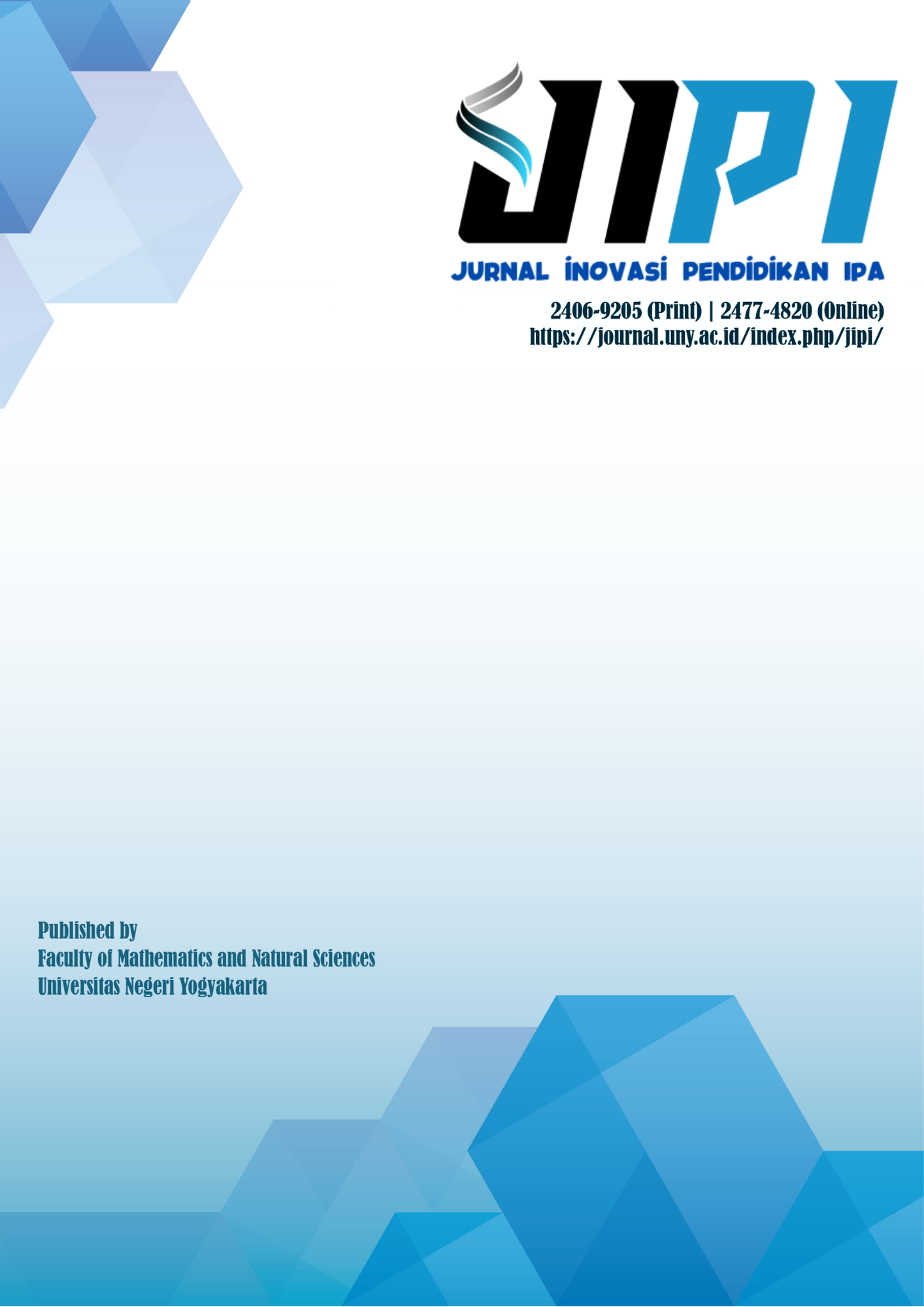Analisis level makroskopis, mikroskopis dan simbolik mahasiswa dalam memahami elektrokimia
DOI:
https://doi.org/10.21831/jipi.v5i2.27517Keywords:
makroskopis, mikroskopis, simbolik, elektrokimia, macroscopic, microscopic, symbolic, electrochemistryAbstract
Penelitian ini bertujuan untuk mengetahui tingkat pemahaman mahasiswa dilihat dari aspek makroskopis, mikroskopis dan simbolik dalam memahami konsep. Fenomena pembelajaran kimia yang ditemukan hampir selalu terfokus pada tingkat makroskopik berupa rumus dan angka, sedangkan tingkat yang sering luput dari pengematan adalah tingkat mikroskopik dan simbolik seperti penyajian diagram dan proses reaksi kimia.Salah satu sifat dari ilmu kimia adalah cenderung bersifat abstrak dan kompleks, seperti proses terjadinya reaksi elektrolisis dimana terjadi pergerakan partikel yang tidak dapat diamati oleh mata sehingga sering terjadi miskonsepsi dalam memahami konsep kimia. Penelitian ini menggunakan metode eksperimen semu dengan pendekantan kuantitatif dilakukan pada mahasiswa semester satu sebanyak 40 orang di prodi Farmasi Universitas Muhammadiyah Prof. DR. Hamka. Sampel penelitian ini diambil secara purposive random sampling dengan kuisioner. Berdasarkan hasil penelitian diperoleh hasil pemahaman mahasiswa pada konsep elektrokimia dilihat dari level makroskopis sebesar 72.75% kategori baik, level mikroskopis sebesar 66.25% kategori baik dan simbolik adalah 70% kategori baik. Sehingga dapat disimpulkan bahwa pembelajaran dengan aspek makroskopis, mikroskopis, simbolik dapat menanamkan konsep secara utuh.
Analysis of macroscopic, microscopic and symbolic levels of students in understanding electrochemistry
Abstract
This research aims to find out the students' comprehension from the macroscopic, microscopic, and symbolic aspects of the concept. The phenomenon of chemistry learning that is found almost focused on the macroscopic level in the form of formulas and numbers, while the level that often missed in some observation is microscopic and symbolic levels; such as diagramming and chemical reaction processes. One of the characteristics of chemistry tends to be abstract and complex, as the process of electrolysis reaction in which the particle movement can't be observed so that misconceptions often occur in understanding chemical concepts. This study uses quasi-experimental methods with quantitative approach conducted by 40 semester students in the first semester of Pharmacy at the University of Muhammadiyah Prof. DR. Hamka. The research sample was taken by purposive random sampling with a questionnaire. Based on the result, the students' comprehension of the electrochemistry concept have 72,75% good category in macroscopic level, 66,25% good category in microscopic level, and 70% good category in symbolic. So, it can be concluded that learning with macroscopic, microscopic, and symbolic could fulfill the concept perfectly.
References
Bodner, M. G., & Domin, D. S. (2000). Mental models: The role of representations in problem solving in chemistry. University Chemistry Education, 4(1), 24–30.
Chittleborough, G. D., & Treagust, D. F. (2009). Why models are advantageous to learning science. Educación Química, 20(1), 12–17. https://doi.org/10.1016/S0187-893X(18)30003-X
Chittleborough, G. D., Treagust, D. F., Mamiala, T. L., & Mocerino, M. (2005). Students' perceptions of the role of models in the process of science and in the process of learning. Research in Science & Technological Education, 23(2), 195–212. https://doi.org/10.1080/02635140500266484
Chittleborough, G. D., Treagust, D. F., & Mocerino, M. (2002). Constraints to the development of first year university chemistry students' mental models of chemical phenomena. Focusing on the Student, 43–50.
Coll, R. K. (2008). Chemistry learners' preferred mental models for chemical bonding. Journal of Turkish Science Education (TUSED), 5(1). Retrieved from http://www.tused.org/index.php/tused/home
Farida, I., Liliasari, L., Sopandi, W., & Widyantoro, D. (2017). A web-based model to enhance competency in the interconnection of multiple levels of representation for pre-service teachers, 359–362. https://doi.org/10.1201/9781315166575-84
Jansoon, N., Coll, R. K., & Somsook, E. (2009). Understanding mental models of dilution in Thai students. International Journal of Environmental and Science Education, 4(2), 147–168.
Kozma, R., & Russel, J. (2007). Representational competence's profile of pre-service chemistry teachers in chemical problem solving in science and science education. Visualization in Science Education, 9–27.
Mansouri, F. (2007). Cultural diversity as an educational advantage. Ethos, 15(3), 15–18.
Rahayu, S., Treagust, D. F., Chandrasegaran, A. L., Kita, M., & Ibnu, S. (2011). Assessment of electrochemical concepts: a comparative study involving senior high-school students in Indonesia and Japan. Research in Science & Technological Education, 29(2), 169–188. https://doi.org/10.1080/02635143.2010.536949
Schwarz, C. V., Reiser, B. J., Davis, E. A., Kenyon, L., Achér, A., Fortus, D., ... Krajcik, J. (2009). Developing a learning progression for scientific modeling: Making scientific modeling accessible and meaningful for learners. Journal of Research in Science Teaching, 46(6), 632–654. https://doi.org/10.1002/tea.20311
Setiawan, A., Fajaruddin, S., & Andini, D. W. (2019). Development an honesty and discipline assessment instrument in the integrated thematic learning at elementary school. Jurnal Prima Edukasia, 7(1), 9–19. https://doi.org/10.21831/jpe.v7i1.23117
Shwartz, Y., Ben-Zvi, R., & Hofstein, A. (2009). Chemical Literacy: What Does This Mean to Scientists and School Teachers? Journal of Chemical Education, 83(10), 1557. https://doi.org/10.1021/ed083p1557
Sirhan, G. (2007). Learning difficulties in chemistry: An overview. The Journal of Turkish Science Education, 4(2), 2–20.
Supriadi, S., Ibnu, S., & Yahmin, Y. (2018). Analisis model mental mahasiswa pendidikan kimia dalam memahami berbagai jenis reaksi kimia. Jurnal Pijar MIPA, 13(1), 1. https://doi.org/10.29303/jpm.v13i1.433
Tasker, R., & Dalton, R. (2006). Research into practice: visualisation of the molecular world using animations. Chem. Educ. Res. Pract., 7(2), 141–159. https://doi.org/10.1039/B5RP90020D
Treagust, D., Chittleborough, G., & Mamiala, T. (2003). The role of submicroscopic and symbolic representations in chemical explanations. International Journal of Science Education, 25(11), 1353–1368. https://doi.org/10.1080/0950069032000070306
Yí¶rí¼k, N., Morgil, I., & Seí§ken, N. (2010). The effects of science, technology, society, environment (STSE) interactions on teaching chemistry. Natural Science, 02(12), 1417–1424. https://doi.org/10.4236/ns.2010.212173
å²¡æˆ¸é †ä¸€, 艾斌, 巴山玉蓮, 櫻井尚å, 藤原佳典, & 星旦二. (2003). 主観的å¥åº·æ„Ÿã‚’ä¸å¿ƒã¨ã—ãŸåœ¨å®…高齢者ã«ãŠã‘ã‚‹å¥åº·é–¢é€£æŒ‡æ¨™ã«é–¢ã™ã‚‹å…±åˆ†æ•£æ§‹é€ åˆ†æž (特集 人々ã®å¥åº·ã‚’支æ´ã™ã‚‹æ–¹æ³•). ç·åˆéƒ½å¸‚ç ”ç©¶, (81), 19–30.
Downloads
Published
How to Cite
Issue
Section
Citation Check
License
The authors submitting a manuscript to this journal agree that, if accepted for publication, copyright publishing of the submission shall be assigned to Jurnal Inovasi Pendidikan IPA (JIPI). However, even though the journal asks for a copyright transfer, the authors retain (or are granted back) significant scholarly rights.
Jurnal Inovasi Pendidikan IPA by http://journal.uny.ac.id/index.php/jipi/index is licensed under a Creative Commons Attribution-ShareAlike 4.0 International License.










